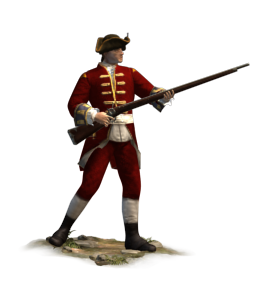Guards (ETW Unit)
Overview
These troops are equipped in much the same way as line infantrymen, and carry smoothbore muskets as their primary weapons. There, however, the similarities end. Their uniforms are altogether more splendid, marking them out as a superior force, in arrogance if nothing else. This attitude can serve them well in battle, as the guard can hardly be seen to be cutting and running, no matter how hot the enemy fire. They are also expected to do a good job as garrison troops, keeping the royal family safe no matter what the locals might think or be tempted to do by some foolish revolutionary fervour.
Historically, the French Maison du Roi (literally “house of the king”) were the epitome of household troops. They provided a ceremonial guard at every state occasion, and Louis XIV picked them from candidates sent in by each regiment; inappropriate candidates brought punishment on the officers who had sent them! The Prussian “Potsdam Giants” were a quirky household guard, the product of Frederick I’s obsession with very, very tall men and military pomp. Oddly, he wasn’t a very warlike chap at all.
Details
Guards represent the very best most nations have to offer in terms of line infantry. They have very high morale, are resistant to morale shocks (such as being charged by cavalry) and can rally routing troops around them. Therefore, they are very reliable and should be used in key positions on the battlefield.
Guards utilize the platoon firing technology. This means that they represent less of a shock value on the battlefield and more of a constant influence. Guards boast very high accuracy so platoon firing is very devastating when used by them despite the smaller amount of firepower deployed.
To prevent overuse, each faction is limited to six units of guards. Every European (and non-native or pirate American) faction, including minor nations, can train generic guards. However, some major factions have a unique assortment of other elite infantry they can also choose from. Like guards, these units generally possess superior statistics to regular line infantry, and utilize platoon firing unless it is unavailable.
Great Britain can train one regiment each of Coldstream Guards and The Black Watch in addition to their regular guards. Two of the three unit DLCs increases their variety and quantity of guards.
France has access to a plethora of unique line infantry guards: Chasseurs Britanniques (6 regiment limit), Royal Eccossais (1 regiment), Infanterie Petit-Vieux (3 regiments), and Infanterie Vieux (3 regiments), in addition to their regular guards, which are instead named Maison du Roix (6 regiments). With the DLC, the French also gain many new guard-type units.
Prussia has access to Life Guards (6 regiment limit) instead of guards, with generally superior statistics to even guards. Prussia can also train Superior Line Infantry (15 regiment limit), which are inferior to guards but higher-quality than line infantry.
Sweden has access to Life Guards of Foot (6 regiment limit), and also has access to Superior Line Infantry (15 regiment limit).
The United Provinces can train 6 Swiss Infantry regiments and 4 Scots regiments in addition to its 6 basic guard regiments, the Holland Guard. In addition, it can train 1 regiment of Blue Guard, which boasts superior statistics to the other guard types.
